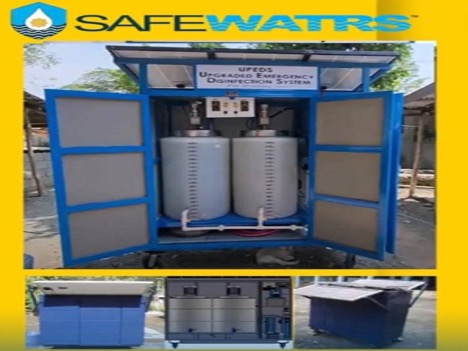
BY LEANDER C. DOMINGO
THE Department of Science and Technology (DoST) in Region 1 (Ilocos Region) has introduced a new technology to help communities suffering from the unavailability of safe drinking water, particularly in far-flung areas.
The equipment, known as “Safewatrs: Emergency Disinfection System of Drinking Water,” is a portable manually controlled and solar-powered emergency drinking water system with a capacity of up to 2,000 liters of safe drinking water for nine hours.
Reynaldo Esguerra of the DoST-Industrial Technology Development Institute (ITDI) Environmental and Biotechnology Division (EBD) recently talked about the system over DZAG Radyo Pilipinas Agoo (La Union) to promote knowledge and advancements in the field.
Also the DoST-ITDI-EBD chief science research specialist, Esguerra noted that as a result of typhoons, flooding, earthquakes and breakouts, among others, “there has been a dearth of sources of drinking water, and this ground-breaking technology has begun to offer a solution.”
“Safewatrs aims to address the shortage or unavailability of water during calamities, emergency situations and even in remote areas where water supply is disrupted or cut off,” he said.
The technology was formerly called Safewatrs Upgraded Emergency Disinfection System; the decision to change the name of Upeds to Safewatrs was made after it became clear that access to safe drinking water was a problem. “Access to safe drinking water has been affecting many people on a regular basis rather than just in times of emergency,” Esguerra said.
Esguerra also noted that in addition to addressing drinking water scarcity, this technology complies with the strict requirements outlined in the Philippine National Standards for Drinking Water (PNSDW).
Chemical removal
Also presented were the features of Safewatrs which is an energy independent using its solar panels, batch type or semi-continuous compact and mobile water treatment system.
“With a capacity of producing 2,000 liters per day, it is also effective in the removal of chemicals and metals in water, making the post-processed water safe for consumption by the public,” Esguerra said.
Besides the disinfecting of salt water, the Safewatrs technology, which can operate on rainwaters, spring waters and turbid waters, has no major differences from the other filtration and disinfection systems.
Esguerra stressed Safewatrs’ philanthropic vision: “… it was developed not for the agency to earn from it, rather it was developed mainly to help the communities.”
According to the DoST-ITDI, the effectiveness of the technology has been proven through its deployment in Bagong Silangan in Quezon City, Agoncillo in Batangas, Santo Domingo in Ilocos Sur and San Clemente in Tarlac.
Esguerra also explained that the technology had its performance testing using the Laguna Lake water, resulting in an excellent rating following the PNSDW.
According to the DoST, the Ilocos Region is currently on the technology’s list of recipients through the efforts of the agency which consistently offers its customers and stakeholders high-quality service and assistance.
These services and assistance are provided through the DoST’s various programs and projects in partnership with various agencies like the DoST-ITDI.
